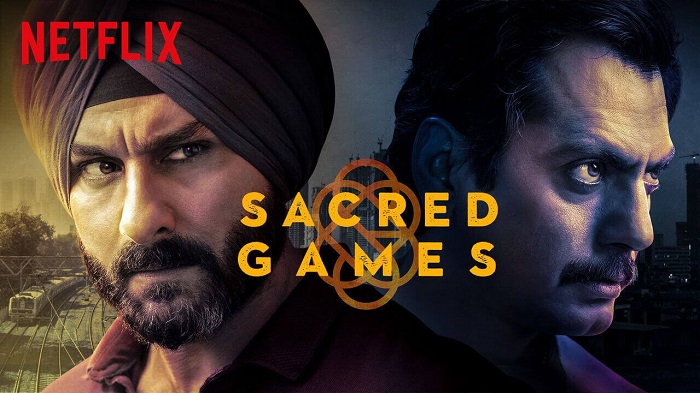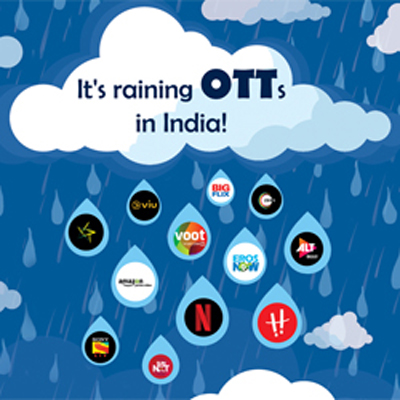Whether it is Sartaj Singh (played by Saif Ali Khan) sprinting through dingy streets in the rainy night, firing bullets Walther PPK-style or the criminals vigorously trying to wade through bullets and explosions to escape arrest, the Netflix special Sacred Games has had us under its spell with its stunning imagery.
With superlative storytelling and equally brilliant VFX game, Sacred Games 2 emerged as India’s crème de la crème in the slate of homegrown content. A thrilling piece of storytelling in the whodunit crime genre presupposes a great deal of action and gore especially when the overarching theme and the landscape packs a hot mix of geopolitics and India’s political timeline spanning over complex character arcs into one plot.

Sacred Games 2 elaborates on how the game becomes larger than any of the characters that we speculated to be the real perpetrator. In order to depict the imagery, visual effects had to be deployed in the most seamless and photo-realistic manner. Bearing that in mind, the OTT giant roped in philmCGI to create VFX imagery for buttressing the storytelling of India’s superhit Netflix series.
AnimationXpress spoke to the VFX supervisor Arpan Gaglani, to know what went on behind the scenes of India’s most popular crime thriller Sacred Games season 2.
Could you discuss as to what role did VFX play in the season two of Sacred Games?
For series like Sacred Games. VFX has to be unseen. We had to create lots of gunshots, fire, blasts, face-aging, and de-aging, prosthetic cleanups, city destructions, PIP, crowd multiplication, Around 1000 shots.

We have seen some chase scenes, fight sequences and fire elements in the series. What sort of software approach and techniques did you deploy to create that imagery?
Our approach was clear, 80% real on set effects and 20% enhancement through VFX for almost every challenge that was presented. It is very important to get real interaction on actors and the location. Be it gunshots, brain splatter splatter, fire, explosions, etc.
For example, we had a long chase sequence with Sartaj and Malcolm in the narrow streets of Mumbai. Long water pipes were installed through the road to create rain. In this situation, rainfall is never consistent and it leaves lots of gaps. So in post, we made sure we filled in those gaps with digital rain and also maintain rain-speed consistency throughout the sequence. And obviously we have to clean up all the pipes from the shots. Similarly, for fire and blasts, we would shoot the real blasts without the actors and then composite them back in the shot. Actors would be shot with animated lights to mimic the blast intensity. In addition to that, we shot a lot of ref plates of real fire and smoke on black, which we later used to further enhance the shot during the compositing stage.
“One of the challenging sequence was that of creating a nuclear blast-stricken city. Although its seen for a very short time in the show, lot has gone into it”
Do you think OTT giants like Netflix are making way for high-quality VFX work given their commitment to dishing out premium streaming services and originals?
Yes Absolutely, if you check most of the originals made by OTT platforms are quality driven and have a high budget for VFX which definitely helps us achieve much better quality VFX . The horizon for VFX has widened and how!! More and more creators are getting confident of using VFX as a part of their storytelling and not just as some patchwork after the shoot. This is also strongly backed by the OTT platforms.

In India, the lack of budget becomes the critical point and the primary obstacle in the process of VFX work. In the last number of months, do you think storytellers and filmmakers are releasing the importance of the VFX department and shelling out the required budgets?
philmCGI Director and VFX supervisor for Sacred Games 2 Arpan Gaglani – I have a different take on this matter. I would refrain from using words like lack of Budgets for VFX. Every Feature, series has its own budget I believe there has to be a clear understanding between the producer, director and the Visual effect supervisor from the beginning. For all my projects, I knew what my budgets are going to be. So it’s my responsibility to make sure I steer the execution to fit everything within my budget and also not compromise the vision of the project. There are times when the script has a lot of stuff written assuming it is possible to execute in VFX. But if the budget does not fit, it has to be changed. We always find a different way to do it. If something is a must, then that budget has to be accounted before we begin the shoot. Even during the shoot, we have to make sure the shooting does not go off track. If you do not control it then, it will backfire as there won’t be budgets left to accommodate. We have been fortunate enough to work alongside directors and producers who understand and are ready for the changes.”
philmCGI director Anand Bhanushali – Yes , in recent years VFX has become the integral part of storytelling and we have seen getting its due share of better budgets , we have seen that Producers, directors, production houses have recognised the importance of VFX and what it can do to enhance the quality of the production and storytelling. More and More planning is being done on VFX as a part of storytelling right from the start i.e Concept and Script stage.

Given the fact that viewers have higher expectations from OTT platforms and Giants like NETFLIX and Amazon Prime and they are committed to living up to those expectations, do you think that the OTT platforms have more spending capacities than linear television productions?
Yes they do, as most of the original content that they produce is not restricted to one territory, its distributed globally on their platforms and hence they definitely have more budgets for their shows. A lot of shows raised the bar and clearly expectation is very high and thus OTT platforms are willing to spend the right amount of money to do justice to the show.
“Netflix has their own pipeline where the shots go through rounds of QC as they’re checked frame-by-frame. At the start of the project itself, they are precise in the way we have to follow the process which is explained clearly”
What are some of the challenges you face in creating the imagery?
Challenges are plenty! If I have to pick my favourite, its TIME! Time has always been my biggest challenge. For a long show, we are completely dependent on the locked edit and we can’t start work till the edit is final and locked. That gives us a small window to accommodate a lot of shots. We try our best to pre-plan as much as possible but we always fall short of time!! Another challenge is working on a 4K pipeline. Now all of a sudden with these 4K monitors we are seeing a lot of errors which we could never see in a 2K monitor.
Also, we are still figuring the best way to smoothen the process as even with the high-end machines it tends to drag and it’s very frustrating for the artists. This challenge is temporary as am confident it will become easier over a course of time!
Tell us about some of the most challenging sequences that tested your VFX prowess?
One of the challenging sequences was that of creating a Nuclear destructed city. Although its seen for a very short time in the show, a lot has gone into it. Given the time, we kept trying to perfect it as much as possible till the last day given. We were working on native 5k exr pipeline,It had all the elements of a complicated shot-creating 3D city, keying, match move, effects like fire, dust particles, smoke, projection technique on certain layers…all having their individual 5k layers…it took a lot of time to see a desirable image and getting it up to mark took us a long time with lots of iterations.
Since the quantum of work has increased in the VFX department, do you think VFX jobs will be created and aspirants will have all the reason to see VFX as a viable career option?
Yes, its ones of the most flourishing careers today and only going to get better. Its a great option for today’s and coming generations. As per our understanding, a lot of projects are already in the pipeline which is heavy VFX. Both international and homegrown. So yes, more jobs will be created and one should definitely choose VFX as a viable career as it will not only provide stability but tons of fun working on it! Imagine the experience when you will watch your film on-screen with your friends and family and you will be pointing out “that”s my shot”!
Tell us about the quality check routines put in place by OTT giants like Netflix.
Netflix has its own pipeline where the shots go through rounds of QC as its checked frame by frame. At the start, they are precise in the way we have to follow the process which is explained clearly. So once you submit the final EXR, it goes to their QC department and they get back to you any errors they find. Technically they want every image to be absolutely correct. If I have to say it in few words, they won’t even let a single “DEAD pixel” pass by in a frame!
Lastly what advice would you give to the budding aspirants who would like to work for your studio?
We are looking for multi-talented, multifaceted artist and not resorting to just one expertise. As a studio, we cater to the creative needs of the show and we expect everyone to be a part in brainstorming and getting the desired output. As long as the Artist is willing to explore all aspects of film making we are more than happy to welcome in our studio.. After all, we are all filmmakers!

